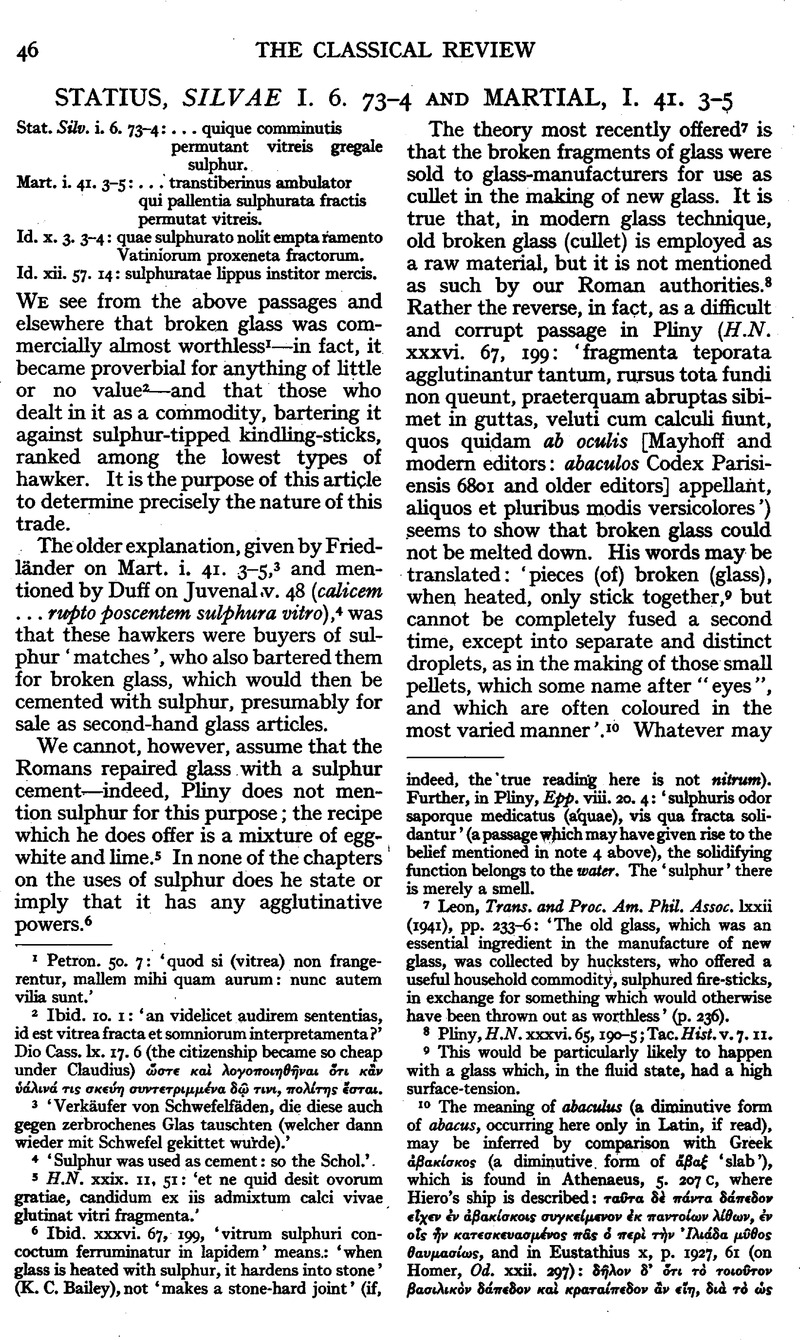No CrossRef data available.
Published online by Cambridge University Press: 27 October 2009

page 46 note 1 Petron. 50. 7: ‘quod si (vitrea) non frangerentur, mallem mihi quam aurum: nunc autem vilia sunt.’
page 46 note 2 Ibid. 10. 1: ‘an videlicet audirem sententias, id est vitrea fracta et somniorum interpretamenta ?’Dio Cass. lx. 17.6 (the citizenship became so cheap under Claudius) ⋯στε κα⋯ λογοποποιηθ⋯ναι ⋯τι κἃν ⋯⋯λιν⋯ τις ακε⋯η αυντετριμμ⋯να δῷ τινι, πολ⋯της ἔσται.
page 46 note 3 ‘Verkäufer von Schwefelfäden, die diese auchgegen zerbrochenes Glas tauschten (welcher dann wieder mit Schwefel gekittet wurde).’
page 46 note 4 ‘Sulphur was used as cement:so the Schol.’.
page 46 note 5 H.N. xxix. 11, 51: ‘et ne quid desit ovorum gratiae, candidum ex iis admixtum calci vivae glutinat vitri fragmenta.’
page 46 note 6 Ibid, xxxvi. 67, 199, ‘vitrum sulphuri concoctum ferruminatur in lapidem’ means.: ‘when glass is heated with sulphur, it hardens into stone’(K. C. Bailey), not ‘makes a stone-hard joint’ (if, indeed, the true reading here is not nitrum). Further, in Pliny, Epp. viii. 20. 4: ‘sulphuris odor saporque medicatus (aquae), vis qua fracta solidantur’ (a passage which may have given rise to the belief mentioned in note 4 above), the solidifying function belongs to the water. The ‘sulphur’ there is merely a smell.
page 46 note 7 Leon, , Trans, and Proc. Am. Phil. Assoc. lxxii (1941), pp. 233–236Google Scholar: ‘The old glass, which was an essential ingredient in the manufacture of new glass, was collected by hucksters, who offered a useful household commodity, sulphured fire-sticks, in exchange for something which would otherwise have been thrown out as worthless’(p. 236).
page 46 note 8 Pliny, , H.N. xxxvi. 65, 190–5;Google Scholar Tac. Hist. v.7.11.
page 46 note 9 This would be particularly likely to happen with a glass which, in the fluid state, had a high surface-tension.
page 46 note 10 The meaning of abaculus(a diminutive form of abacus, occurring here only in Latin, if read), may be inferred by comparison with Greek ⋯βακ⋯σκος (a diminutive, form of βαξ‘slab’), which is found in Athenaeus, 5. 207 c, where Hiero's ship is described: τα⋯τα δ⋯ π⋯ντα δ⋯ντα δ⋯πεδονεἶχεν ⋯ν ⋯βακ⋯σκοις συγκε⋯μενον λ⋯θων, ⋯νοἶς κατεσκευασμ⋯νος π⋯ς ⋯ περ⋯ τ⋯ν Ἰλι⋯δα μ⋯θος θαυμασἰως, and in Eustathius x, p. 1927, 61 (on Homer, Od. xxii. 297): δ⋯λον δ' ⋯τι τ⋯ τοιο⋯τον βασιλικ⋯ν δ⋯πεδον κα⋯ κρατα⋯πεδον ἄν εἴη, δι⋯ τ⋯ ὡς. We may conclude that άβακ⋯σκος was a technical term for a small stone used in the making of mosaics, and similarly that abaculus was a Latin technical term, meaning a small pellet used in mosaics. In the present case it would be of glass.
page 46 note 1 H.N. xxxvi.67, 198:Google Scholar ‘ibifit et album, et murrina aut hyacinthos sapphirosque imitatum, et omnibus aliis coloribus, nee est aha nunc sequacior materia aut etiam picturae accommodatior’(‘we possess… none which is more suitable for mosaic patterns’ —K. C. Bailey: see his note there, and cf. Stat. silv. i. 3. 55: ‘varias ubi picta per artes gaudet humus, superatque novis asarota figuris’; Aug. Civ. Dei xvi.8: ‘hominum genera, quae in maritima platea Carthaginis musivo pida sunt’; Trebell.Poll. Trig. Tyr. xxv. 4: ‘accipiens coronam civicam, picturatam de musivo’).
page 46 note 2 For a glass floor, cf. Anth. Pal. xiv. 52: ὑελ⋯νῳ κε⋯μενον ⋯ν δαπ⋯δῳ
page 46 note 3 Cf. Symm. viii. 42: ‘novum musivi genus et intentatum … ornandis cameris.’
page 46 note 4 Taken by Daremberg and Saglio, vol. iii, p. 2097, as referring to opus musivum in glass.
page 46 note 5 Compare the amusing epitaph on a musivarius (in Dessau, Inscr. Sel. 7671), who fell off his ladder and was killed: ‘hic sit(us)…prima iuventa fuit: dum varias cupit spec(ies) museo figere in alto decidit.’
page 46 note 6 The source of sulphur nearest to Rome was in the Leucogaean Hills, near Naples, about 130 miles south of the city (Pliny, , H.N. xviii. 297, 114, xxxv.50, 174Google Scholar). If the huckster went on an expedition to dig it up for himself, transtiberinus ambulator (Mart. i. 41. 3) may have a double meaning, and thus gain added significance!